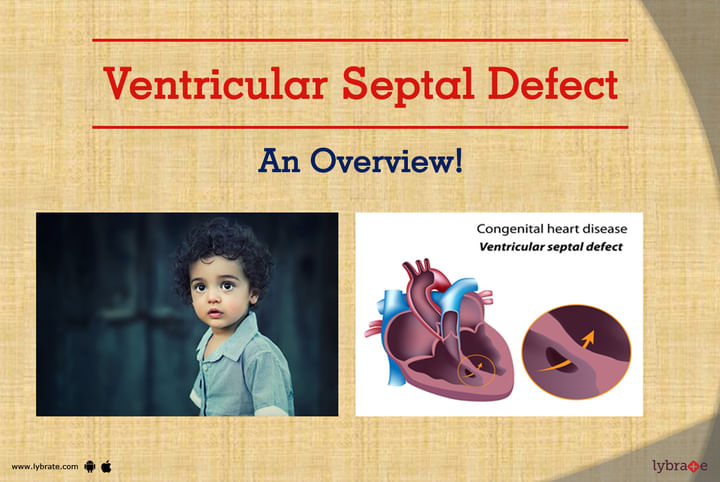Ventricular Septal Defect - An Overview!
VSD (a hole in the heart) refers to a congenital heart disease where a hole is formed in the ventricle septum i.e. wall between two lower chambers of the heart. As a result of this, blood from the left portion of the heart (left ventricle) crosses this hole and goes to right-sided heart that results in blood overflow to lungs.
VSD is one of the commonest child heart diseases that is seen at birth, but adults too may suffer from it following an acute heart attack.
What are the causes for Ventricular Septal Defect?
Congenital VSD occurs during heart development of the fetus. The heart develops from a huge tube, dividing into sections that, in turn, will become the chambers, walls and vessels of the heart. If something goes wrong during this process, a hole can develop in the ventricular septum.
Sometimes, VSD may be caused due to genetic and environmental factors. For instance, if you have a family history of genetic conditions like Down syndrome or congenital heart diseases, then your child may be at risk of developing a Ventricular Septal Defect.
Symptoms Indicating VSD-
The signs and symptoms of Ventricular Septal Defect vary depending on the size of the VSD. If the hole is small, child may be asymptotic. Children or young adults with small VSD only show signs of a heart murmur that is detected by their family physician.
A medium or large sized hole is likely to exhibit the following noticeable symptoms in children –
- Rapid breathing/Breathlessness
- Poor weight gain/ Failure to thrive
- Poor feeding
- Tiredness and fatigue
- Excessive sweating
- Inability to engage in physical activities
- An enlarged heart
- A tint of blue on the lips, fingernails, and skin in late stages of large VSD
These symptoms indicate that the VSD will most likely not close by itself, and therefore, require urgent intervention. If left untreated, Ventricular Septal Defect may lead to further complications such as pulmonary hypertension, endocarditis, or Eisenmenger like situation.
How is VSD diagnosed?
Usually, VSD is detected within the first few weeks after the birth of the child during a routine check-up. The doctor can tell if your child has a hole in the heart by hearing a heart murmur, as oxygen-rich blood passes between the two ventricles.
Suspecting VSD, your doctor may refer you to a paediatric cardiologist, who will then perform a physical examination on your child, taking his/her medical history in consideration. The following tools are used to confirm the diagnosis –
- An X-ray of the chest
- An electrocardiogram or ECG
- Most importantly by doing a pediatric echocardiogram (ECHO): this is done from the child's chest, a non-invasive modality with no pain to the child
What is the treatment?
Treatment of VSD depends on the size of the hole, and the age and weight of the child.
A small VSD with no significant symptoms mostly will require only follow-up. The child can do his/her activities without much fear.
Moderately sized VSD children are having poor weight gain and show signs of heart failure but less as compared to large VSD. These VSD needs to be followed up to 9-12 months of age and needs to close. The method of closure of moderate sized VSD depends on its location and size of VSD. Majority of moderate sized VSD can be closed by using a device in cath lab angiographically (VSD device closure non-surgically) or else by doing open heart surgery.
In a case of large VSD: Child shows signs of heart failure or in respiratory distress then first medical therapy in the form of diuretics are prescribed for decreasing the signs of heart failure. Then VSD surgical closure is advised preferably between 3-6 months of age.
Heart Surgery – This involves making an incision in the chest wall and maintaining circulation with the help of a lung-heart machine while closing the hole. The surgeon may either seam the hole or stitch a patch of material over it. The heart tissue will eventually heal over the stitches or patches. In about six months, the tissue will cover the hole completely.
Another treatment option is cardiac catheterization.
Cardiac Catheterization (Non-surgical closure of VSD)– The cardiologist inserts a catheter into the blood vessel in child legs that reach up to the heart. He/she then guides the tube to make measurements of blood pressure, blood flow, and level of oxygen in the chambers of the heart. A special implant known as a device is placed into the septal hole (VSD). The device flattens against the septum on both the sides to permanently heal and close the VSD.
Having your child diagnosed with a heart defect can be scary. However, consulting a paediatric cardiologist at the earliest can be helpful, as he will be familiar with Ventricular Septal Defect, and can tell you the best way to manage the condition.



+1.svg)
